高考非谓语动词不定式用法小结
非谓语动词的用法总结

非谓语动词的用法总结动词不定式(一) 时态1. 一般式动词不定式的一般式表示与谓语动词同时或之后的行为。
如: I want to have a restI plan to attend the meeting 2. 完成式不定式的完成式表示不定式的动作发生在谓语动词所表示的动作之前的行为。
如:I ’m sorry to have kept you waiting. 3进展式不定式的动作假如同谓语动词所表示的动作同时发生那么使用不定式的进展式。
如: They seemed to be talking about something important. 4. 完成进展式不定式的完成进展式表示在谓语动词之前已经发生,并且一直进展着的动作。
如: He is said to have been working in that factory for twelve years. 〔二〕动词不定式用法:1. 作主语To master English gives us much help in the study of science 2. 作宾语I want to leave here soon. He pretended to be a doctor. 3. 作表语The most important thing is to study hard. 4. 作宾语补足语不定式作定语必须放在被修饰的名词或代词的后面。
I have no time to talk with her. 6. 作状语不定式作状语时可以表示目的、原因、结果或条件。
I came here to learn from you ( 目的) I ’m very glad to heard the news。
〔原因〕 He is old enough to go to school.(结果) To look at him ,you can’t help laughing.Notes:7. 不定式的复合构造。
高中英语非谓语动词用法小结

高中英语非谓语动词用法小结非谓语动词是指不带有人称和时态的动词形式。
在英语中,非谓语动词包括不定式、动名词和分词(现在分词和过去分词)。
它们可以用作主语、宾语、表语、定语、状语等。
一、不定式(Infinitive)不定式是由to加上动词原形构成的,常用于以下情况:1. 作主语To learn a foreign language is not easy. 学习一门外语并不容易。
2. 作表语His ambition is to become a pilot. 他的野心是成为一名飞行员。
4. 作宾语补足语He considers it necessary to improve his oral English. 他认为提高口语英语很有必要。
6. 作状语She woke up early to catch the first bus. 她早起为了赶上第一班公交车。
二、动名词(Gerund)动名词是以-ing结尾的,既可以作名词又可以作动词,常用于以下情况:1. 作主语Swimming is good for health. 游泳对健康有好处。
4. 作定语The laughing children caught my attention. 那些笑着的孩子吸引了我的注意力。
三、分词(Participle)分词有现在分词和过去分词两种形式,分别以-ing和-ed结尾,常用于以下情况:3. 现在分词作状语表示时间、原因、结果等Feeling bored, he decided to take a walk. 因为感到无聊,他决定去散步。
5. 现在分词或过去分词作宾语补足语I saw him driving his new car. 我看到他开着他的新车。
总结:1. 不定式和动名词不能作定语,分词可以;2. 不定式和分词都有现在和过去两种形式,动名词只有现在形式;3. 不定式和动名词只能用于名词后做宾语,分词还可以修饰主语或作状语;4. 不定式和分词有时态,动名词没有。
高中英语知识点归纳非谓语动词的用法总结
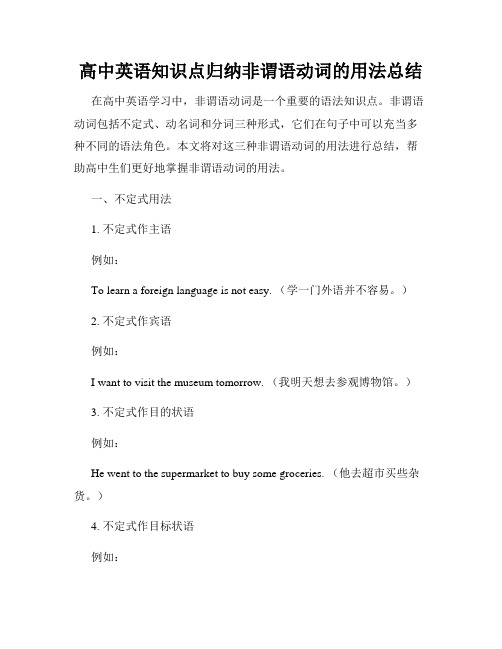
高中英语知识点归纳非谓语动词的用法总结在高中英语学习中,非谓语动词是一个重要的语法知识点。
非谓语动词包括不定式、动名词和分词三种形式,它们在句子中可以充当多种不同的语法角色。
本文将对这三种非谓语动词的用法进行总结,帮助高中生们更好地掌握非谓语动词的用法。
一、不定式用法1. 不定式作主语例如:To learn a foreign language is not easy. (学一门外语并不容易。
)2. 不定式作宾语例如:I want to visit the museum tomorrow. (我明天想去参观博物馆。
)3. 不定式作目的状语例如:He went to the supermarket to buy some groceries. (他去超市买些杂货。
)4. 不定式作目标状语例如:We need to study hard to pass the exam. (为了通过考试,我们需要努力学习。
)5. 不定式作定语例如:The girl to my left is my best friend. (我左边的那个女孩是我最好的朋友。
)二、动名词用法1. 动名词作主语例如:Swimming is my favorite sport. (游泳是我最喜欢的运动。
)2. 动名词作宾语例如:He enjoys playing basketball. (他喜欢打篮球。
)3. 动名词作介词宾语例如:She is good at dancing. (她擅长跳舞。
)4. 动名词作宾语补足语例如:I find it difficult to understand his speech. (我觉得理解他的演讲很困难。
)5. 动名词作定语例如:The running water sounds so relaxing. (流水的声音听起来很放松。
)三、分词用法1. 现在分词作定语例如:The book on the table is mine. (桌子上的那本书是我的。
非谓语动词(不定式)的用法
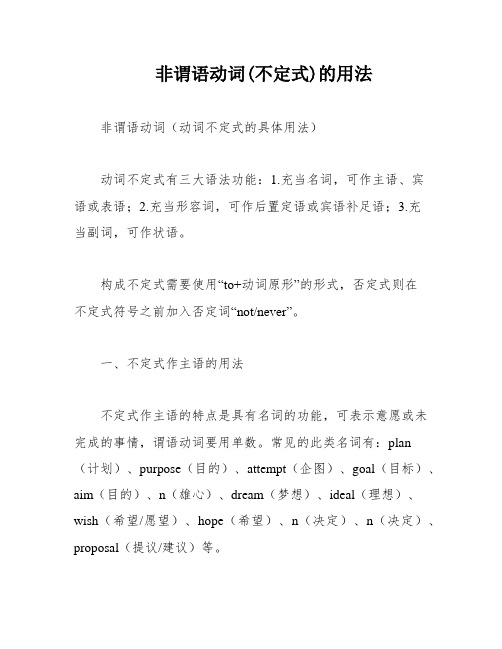
非谓语动词(不定式)的用法非谓语动词(动词不定式的具体用法)动词不定式有三大语法功能:1.充当名词,可作主语、宾语或表语;2.充当形容词,可作后置定语或宾语补足语;3.充当副词,可作状语。
构成不定式需要使用“to+动词原形”的形式,否定式则在不定式符号之前加入否定词“not/never”。
一、不定式作主语的用法不定式作主语的特点是具有名词的功能,可表示意愿或未完成的事情,谓语动词要用单数。
常见的此类名词有:plan(计划)、purpose(目的)、attempt(企图)、goal(目标)、aim(目的)、n(雄心)、dream(梦想)、ideal(理想)、wish(希望/愿望)、hope(希望)、n(决定)、n(决定)、proposal(提议/建议)等。
为了避免主语过长,不定式短语可放在句末,用形式主语“it”代替原来的主语位置,不定式则成为真正的主语。
例如:___.(赢得冠军是我的雄心。
)To master a foreign language is necessary.(掌握一门外语是有必要的。
)To e President of the United States used to be my goal.(过去我的梦想是成为美国总统。
)Speaking perfect English is always my dream.(说一口流利的英语一直是我的梦想。
)It is ___.(保护环境是有必要的。
)There are two special ___:1) It is + adj + of sb + to do sth.2) It is + adj + for sb + to do sth.___ characteristics and differences are:1) If ___ characteristics or traits。
the logical subject of the ___ "of."Examples:It is very affable of you to help me。
高中英语非谓语动词用法小结
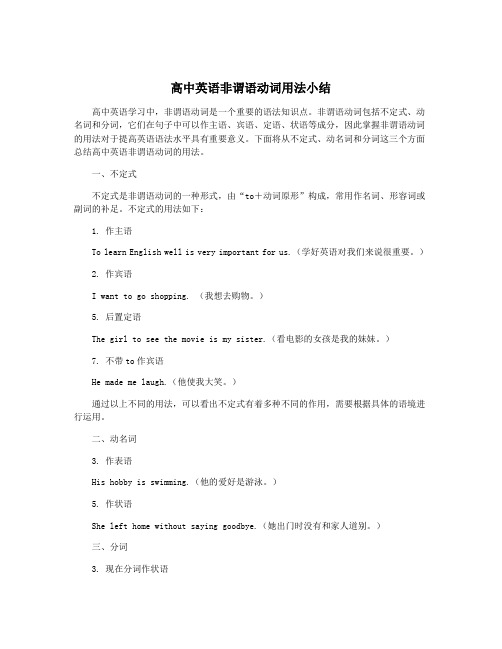
高中英语非谓语动词用法小结高中英语学习中,非谓语动词是一个重要的语法知识点。
非谓语动词包括不定式、动名词和分词,它们在句子中可以作主语、宾语、定语、状语等成分,因此掌握非谓语动词的用法对于提高英语语法水平具有重要意义。
下面将从不定式、动名词和分词这三个方面总结高中英语非谓语动词的用法。
一、不定式不定式是非谓语动词的一种形式,由“to+动词原形”构成,常用作名词、形容词或副词的补足。
不定式的用法如下:1. 作主语To learn English well is very important for us.(学好英语对我们来说很重要。
)2. 作宾语I want to go shopping. (我想去购物。
)5. 后置定语The girl to see the movie is my sister.(看电影的女孩是我的妹妹。
)7. 不带to作宾语He made me laugh.(他使我大笑。
)通过以上不同的用法,可以看出不定式有着多种不同的作用,需要根据具体的语境进行运用。
二、动名词3. 作表语His hobby is swimming.(他的爱好是游泳。
)5. 作状语She left home without saying goodbye.(她出门时没有和家人道别。
)三、分词3. 现在分词作状语Walking along the street, I met an old friend.(沿着街道走,我遇见了一个老朋友。
)5. 过去分词作表语The door is broken.(门坏了。
)分词作为非谓语动词同样具有多种不同的用法,需要根据句子结构进行分析和运用。
(完整版)非谓语动词(不定式)的用法

非谓语动词(动词不定式的具体用法)Step1. 动词不定式的3大语法功能(1)不定式可充当主语,宾语,表语,具有名词的功能.(2)不定式可充当后置定语或宾语补足语,具有形容词的功能.(3)不定式可充当状语,具有副词的功能..Step2.不定式的构成,即:“不定式符号to+动词原形”.Step3. 不定式的否定式,否定词一定放在不定式符号之前,即:“not/never+不定式+动词原形.一,不定式作主语的用法.特点:“to+动词原形”所形成的形式具有名词功能.名词可在句中充当主语,宾语或者表语,同理,不定式也有相同的功能.1. 不定式作主语的特点:(1)可以表示一种意愿或未完成的事.(2)谓语动词用单数.E g: To win the championship is my ambition.主语系动词表语译文:赢得冠军是我的雄心.E g: To master a foreign language is necessary.主语系动词表语译文:掌握一门外语是有必要的.E g: To become President of the United States used to be my goal.主语谓语宾语译文:过去我的梦想是成为美国总统2. 不定式作主语时,be动词之后的表语若是名词,一定是表示意愿,目的,企图等名词,用来表示尚未完成的事情.常见的此类名词有:plan(计划), purpose(目的),attempt(企图),goal(目标), aim(目的), ambition(雄心),dream(梦想), ideal(理想), wish(希望/愿望),hope(希望), decision(决定),determination (决定),proposal(提议/建议).E g: To speak perfect English is always my dream主语系动词表语译文:说一口流利的英语一直是我的梦想.3. 由于不定式短语作主语,显得主语过长,为了避免头重脚轻,达到句子平衡,把不定式短语放在句末,在原来主语的位置上“it”代替,形式上占一个主语的位置,称之为形式主语,不定式称为真正的主语.E g: It is necessary to protect the environment.形式主语系动词表语不定式作真正主语译文:保护环境是有必要的.4. 不定式作主语的两种特殊结构(1)句型:It is +adj(形容词)+of sb +to do sth.(2) 句型:It is +adj(形容词)+for sb +to do sth.特点和区别:(1)若形容词表示人的本质特征,特性,就用“of”引出的不定式的逻辑主语.A:表示人的本质特征和特性的形容词有:“good; nice; clever; wise; foolish; silly; stupid; rude; (im)polite , careless; careful; affable.E g: It is very affable of you to help me.译文:你真好帮助我.E g: It is very careless of you to lose your wallet.译文:你真粗心大意把钱包丢了.(2) 若形容词表示的不是逻辑主语的特性,而是描述对逻辑主语所做的事情,就用介词“for”,B:常见的此类形容词有:“easy; hard; difficult; heavy; necessary; impossible; important.E g: It is impossible for me to get to the destination on time inan hour.译文:一个小时之内按时达到目的地对我来说是不可能的.E g: It is very difficult for me to work out the math problem.译文:解决这个数学问题对我来说太难了.(3) 形容词表示人的特性的句子可转化成一个不定式作状语的句子,而后者则不能.E g: It is very kind of you to help me with my English可转化为一个不定式作状语的句子= You are very kind tohelp me with my English.二,不定式作宾语的用法.(1)作及物动词的宾语,该及物动词均为表示意愿,企图的动词,表示具体的或者特定的动作,或者是将来的动作.常见的动词如下:want(要); wish(希望); hope(希望); desire (欲望/渴望); intend意图;try(设法); determine(决定); decide(决定); attempt(企图); endeavor(努力); plan(计划); like(喜欢); love(喜欢); expect(期望/盼望);pretend(假装); afford(承担得起); manage(设法); prepare(准备); long (盼望); arrange(安排); promise(答应/许诺); learn(学会);dare(敢);agree(同意);start/begin(开始); fail(失败); refuse(拒绝); 等.E g: I want to take a trip abroad next year.主语及物动词不定式作宾语时间状语译文:明年我要出国旅游.E g: I intend to visit you tomorrow主语及物动词不定式作宾语时间状语译文:我打算明天去拜访你.E g: He tried to kill two birds with one stone.译文:他设法一箭双雕.E g: I expect to get a raise.译文:我渴望获得加薪.E g: I can’t afford to buy a new car.主语及物动词动词不定式作宾语译文:我买不起新车.(2)若作宾语的不定式太长,如果其后还有形容词或名词担当宾语补足语,常用“it”作形式宾语,把不定式短语作真正的宾语后置.基本句式:“主语+及物动词+it(形式宾语)+名词/形容词(宾语补足语)+to+动词原形(真正宾语)”.常见的此类动词有“find(发现); think(认为); believe(相信); consider(认为); deem(认为); feel(觉得); make(使)E g: I think it useful to learn English well.主语及物动词形式宾语宾补不定式作真正的宾语译文:我认为学好英语是很有用的.E g: I deem it necessary to apologize to others.主语及物动词形式宾语宾补不定式作真正的宾语译文:我认为向别人道歉是有必要的.E g: I deem it an honor for me to give this speech.译文:能在这里进行演讲我认为这是我的荣幸.E g: We found it impossible to finish the project in a month.主语及物动词形式宾语宾补不定式作真正的宾语译文:我发现一个月之内完成这个项目是不可能的.E g: I make it a rule to get up early.说明:Make it a rule to+v 表示“把--------当作常例/习惯于-------------”.译文:我习惯早起.E g: The teacher made it a rule to speak only English in class.主语及物动词形式宾语宾补不定式作真正的宾语地点状语.译文:老师规定在课堂上这能讲英语.E g: I felt it stupid for him to talk like that.译文:我觉得他这样讲话挺愚蠢的.(3)疑问代词:“what ; which; whom +动词不定式(to+do)”共同作及物动词的宾语的用法特点:不定式后面的动词一定为及物动词,疑问单词“what ; which; whom”及物动词或者介词的宾语.E g: I can’t decide which one to buy.主语及物动词共同作宾语译文:我决定不了买哪一个.know what to do next.E g: I don’t译文:我不知道下一步该怎么办.E g: I can’t decide whom to turn to for help.译文:我决定不了向谁求救.E g: I hardly know what to say to you.译文:我简直不知道该对你说什么.(4)疑问代词:“what ; which; whom +动词不定式(to+do)”共同作及物动词直接宾语的用法E g: Would you please tell me which course to take?主语及物动词间接宾语直接宾语译文:你能告诉我应该选哪门课程吗?(5)疑问副词:“when; where; how;whether+动词不定式(to+do)”共同作及物动词宾语的用法特点:(1)不定式后面的动词可以为不及物动词.(2)不定式后面的动词也可为及物动词,且后面有宾语.E g: He patiently showed me how to operate the computer.主语状语及物动词间接宾语直接宾语译文:他耐心地教我怎么使用电脑.tell me when to start.E g: He didn’t译文:他并没有告诉我什么时候出发.know whether to go or stay.E g: I don’t译文:我不知道是走还是留.E g: I just wonder where to spend the weekend.译文:我只是想知道该去哪里度过周末.E g: Life is long if you know how to live it.译文:若知如何使用,生命就会长久.三,不定式作表语的用法.特点:(1)主语均为表示:“意愿”或者“企图”的名词.(2)不定式作表语可换作主语.E g: His only wish at present is to sleep.主语时间状语系动词动词不定式作表语译文:他此刻唯一的愿望就是去睡觉.可转化为:To sleep is his only wish at present.E g: His goal is simply to become an excellent English teacher.主语系动词状语动词不定式作表语译文:他的目标就是当一名优秀的英语教师.E g: His resolution is to become a great scientist.主语系动词动词不定式作表语译文:他的志愿时当一名伟大的科学家.E g: My dream is to become a successful businessman.译文:我的愿望是成为一名成功的商人.E g: The problem is to find a solution.译文:问题是得找出一个解决办法.E g: Shaking one’s fist is to show one’s determination.译文:挥拳头是显示一个人的决心.E g: The purpose of yelling English is to build up your confidence.译文:大喊英语的目的是建立你的自信心.不定式作表语的2种特殊情况(1)动词不定式作主语,也可作be动词之后的表语,主语和表语的动词形式一定要对称.E g: To see is to believe不定式作主语系动词不定式作表语译文:眼见为实E g: To love her this way is to worship her.不定式作主语方式状语系动词不定式作表语译文:这样爱他就等于崇拜她.(2)在下列句型中,be动词之后的to可省略,接动词原形作表语.E g: All you have to do is (to) take a good rest.主语系动词表语译文:你所要做的就是要好好的休息.E g: All I can do is (to) wait主语系动词表语译文:我所能做的就是等待.E g:What you should do is simply (to) apologize to him主语系动词状语表语译文:你应该做的事就是向他道歉.四,不定式作后置定语的用法.相当于形容词的功能.特点:(1)动词不定式作定语时一定要放在所修饰词的后面,作后置定语.(2)动词不定式与所修饰的名词之间有动宾关系.(3)不定式后面的动词为及物动词,若为不及物动词,一定要加上相应的介词.E g: I have a pile of homework to do tonight.主语及物动词宾语不定式作后置定语时间状语.译文:今晚我有一大堆的作业要做.不定式作后置定语的特殊用法(1)不定式作后置定语可以等于关系代词作主语所引导的定语从句.E g: I have no friend to advise me.主语谓语宾语不定式作后置定语等价于:I have no friend who can advise me.译文:我没有朋友可以给我忠告.(2)不定式作后置定语可以等于关系代词作宾语所引导的定语从句.E g: I have no one to talk to主语谓语宾语不定式作后置定语等价于:I have no one whom I can talk to.译文:我没有人可以交谈.E g: There are many sights to see here.等价于:There are many sights which we can see here.译文:这里有很多的风景可看.(3)主动的不定式和被动不定式的区别. A: 如果句子的主语是要做那件事的人,就用主动形式.B: 如果句子的主语是要做的动作(或者是接受动作的人或事),就用被动式.E g: I have two coats to wash.E g: Two coats are to be washed.(4) 在:“there be ”结构中的不定式可用主动式,也可用被动式,且意思一样.E g: There is an important thing to do tonight= There is an important thing to be done tonight.(5)不定式修饰序数词一定要放在其后.A:Li was the first to arrive.B: Really? That’s not like him. He’s always the last one to arrive.A: 李是第一个到的.B: 真的吗?那可不像他的作风,他总是最后一个到.五,不定式作状语的用法.特点:不定式作状语多放在被修饰的动词,副词,和形容词之后.注意其逻辑主语必须和句子的主语保持一致.在句中充当状语,表示目的;结果或原因.(1)不定式修饰动词的用法,一定置于该动词之后.E g: We should do whatever we can to save them.主语及物动词宾语从句不定式作目的状语的用法译文:我们应该做些什么才能挽救他们呢.(2) 不定式修饰动词作目的状语的用法.特点:不定式作目的状语,通常置于动词之后,也可置于句首,用逗号与主语隔开.E g: You should work very hard to win the award.主语谓语状语不定式作目的状语等价于:To win the award, you should work very hard译文:为了要赢得这个奖项,你应该努力奋斗.E g: I’ll do everything I can to help you.(目的)译文:我会竭尽全力帮你的.E g: You’re really very kind to say so.(原因)译文:你这么说真是太好了.还有类似不定式短语有:(1)in order to+动词原形..即可放在句首,也可句末.(2)so as to+动词原形.只能放在句末.(3)only to;(4) too-------to 太-------而不能(3)with an eye to +动名词. 只能放在句中. (4)with a view to +动名词. 只能放在句中.E g: He got up early in order to catch the school bus.主语谓语不定式作目的状语译文:他早起的目的就是能搭上校车.(3)不定式修饰形容词,一般置于该形容词之后.特点:一般表示一种结果.E g: He is able to do amazing things.主语系动词表语不定式作结果的用法译文:他能成就伟业.E g: He is apt to lie to me .主语系动词表语不定式作结果的用法.译文:他爱向我撒谎.E g: She was prepared to face the music.译文:她准备好面对后果.疯狂操练:I’m determined to conquer English. 我决心攻克英文I’m determined to master pronunciation. 我决心攻克发音.I’m determined to speak good English. 我决心说好英语.I’m determined to become a grammar king. 我决心成为语法大王I’m determined to command a lot of words. 我决心掌握大量词汇.I’m determined to write beautiful articles. 我决心写出漂亮文章.I’m determined to communicate with the world. 我决心与全世界沟通.(4)不定式修饰副词,一定置于该副词之后. 特点:一般表示一种结果.E g: He is old enough to go swimming alone.主语系动词表语状语(副词)不定式作结果的用法. 译文:他长大了,足以单独一个人去游泳.五,不定式作宾语补足语的用法.(1)具有使役动词意味的及物动词,加上宾语之后,要用不定式短语作宾语补足语.此类动词有:1) cause/get 促使-----------;2) lead引导--------说明:‘加上宾语之后,可接to引导的不定式短语,但此时to视为介词,接动名词作其宾语”;3) allow/permit允许------4)advise 劝告---------5)persuade说服----------6)enable使能够----------7)tell告诉-------8)beg/ask请求--------9)order命令---------10)want/wish/expect/intend期望---------11)force 迫使----------------.12)encourage鼓励-------.E g: The sad story caused him to cry.主语及物动词宾语不定式作宾语补足语译文:这个悲惨的故事使他哭了.E g: His timely help enabled me to finish the project in advance.主语及物动词宾语不定式作宾补时间状语译文:他及时的帮助使我能提前完成这个项目.allow me to smoke in the office.E g: They don’t主语及物动词宾语不定式作宾补地点状语译文:他们不允许我在办公室里吸烟.E g: I ask my students to yell English every morning.主语及物动词宾语不定式作宾补时间状语译文:我要求我的学生每天早上都大喊英语.E g: My parents want me to become a great lawyer in thefuture.译文:我的父母希望我将来成为一位很棒的律师.E g: The boss forces his staff to work like a dog for him.译文:老板强迫员工为他拼命干活.E g: My teacher encouraged me to try again.译文:我的老师鼓励我再试一次.(2)使役动词或者是感官动词,动词不定式作宾语补足语“to”要省略.巧记不定式作宾补省略“to”的两大规则A:“注意让‘买客’听听看看这块表有啥感觉不带“土”B: 五看(see; watch; notice; observe; look at); 三让(let; make; have);两听(hear; listen to); 一感觉(feel); 一发现(find); 半个帮(help).1)感官动词,宾语补足语接原型动词,表示已发生的事实..若出现在被动语态中,“to”要还原.E g: I noticed a thief slip into my room just now.主语及物动词宾语省略不定式原型动词作宾补时间状语译文:我刚才注意一个贼溜进我的房间了.E g: I never heard him speak English.译文:我从未听过他说英语.E g: The man was seen to leave the accident.(被动语态中不定式要还原)译文:有人看见他离开事故现场.2)使役动词(make/ let/ have)的具体用法.{1}“make”的常见用法. 若出现被动语态时“to”要还原.※make +宾语+宾补(形容词)E g: The news made me happy.主语及物动词宾语形容词从当宾语补足语.译文:这则消息使我很开心.※make+宾语+宾补(省略“to”的动词原形).疯狂操练 E g: My mother made me walk the dog. My father made me sweep the floor. My grandmother made me wash the dishes. My grandfather made me buy him cigarettes. Everyonein me family made me do something yesterday. I really enjoy helping other people.译文:我妈妈让我去遛狗.我爸爸让我擦地板.我奶奶让我洗碗.我爷爷让我给他买烟.昨天家里的所有人都让我干活了.我真的很乐意帮助他人.E g: These workers are made to work at least 18 hours each day.译文:这些工人被迫每天至少工作18小时.{2}“let”的用法. 很少出现被动语态中.※Let’s +动词原形. 让我们一起-------------------------E g: Let’s have dinner together tonight. 译文:让我们今晚一起吃晚饭.※Let us +动词原形. 让我们一起------------E g: Let us help Tom clean the room. 译文:让我们大家一起帮助汤姆打扫房间.※Let sb++动词原形. 让某人做某事.E g: Let me help you. 译文:让我来帮助你. {3}“have”的用法. 很少出现被动语态中.※have +宾语(人/)+宾补(过去分词充当)表示:请某人做某事※have +宾语(物/)+宾补(过去分词充当)表示:可以用来主语的遭遇或经历,并不是故意让某事发生的.特点:1) 作宾语补足语的动词与宾语之间是被动关系.2)该动作常不属于主语的动作.E g: I had my hair cut yesterday主语使役动词宾语过去分词作宾补时间状语译文:我昨天理的发.E g: Please have the boy taken to the station.译文:请找人把这男孩带到E g: The old man had his leg broken when he fell off the bike.译文:那老人从自行车上摔下来时把腿摔断了.※have+宾语(人/)+宾补(动词原形)表示“让某人做某事”E g: The director had his assistant pick up some hot dogs for the meeting.译文:主管让他的助理为这次会议准备一些热狗.※have+宾语(人/物)+宾补(动名词)表示:“让某人或某事不停地,或者一次又一次地进行某一动作.E g: He had us laughing all through. 译文:整顿饭期间他让我们笑个不停.六,不定式充当独立主格的用法.特点:不定式可以在句中充当独立成分,用来说明说话人的态度,对全句进行解释常见的有:“to be frank; to be honest; to tell the truth; to be blunt”等E g: To tell the truth, I have no money with me today.译文:我今天一分钱也没有带.E g: To be frank, you need to lose weight.译文:坦白说,你真的需要减肥.E g: To be blunt, that’s a stupid idea.译文:老实说,这想法真愚蠢.七,原型不定式的特殊结构.下列为与原型不定式连用的特殊结构.这些结构经常出现在各类英语考试中,务必要牢记.1): do nothing but +动词原形. 除了-----,无所事事.E g: He did nothing but eat all day.译文:他整天什么也不做,只是吃.分析步骤如下:第一步:句中的but 可视为并列连词,连接对等且形态相同的词类did,即He did nothing but did----------.第二步:我们知道do/does/did用于肯定句中,可视为强调性的助动词,之后要接动词原形.试比较:未强调前: He works hard. 他用功. 强调后:He does work hard. 他的确很用功.第三步:因此,在He did nothing but did----------中,did之后要接动词原形.即He did nothing but did eat all day.第四步:并列连词but之后相同的词类可以省略.本句中第一个did为不及物动词的一半过去时,而第二个did则为强调性的助动词,虽然性质不一,但外形相同,故第二个did可省略,即:“He did nothing but eat all day”.2): Choose/expect/want/desire nothing but to+动词原形.E g: He wanted nothing but to sleep. 译文:他什么都不要,只想睡觉.3): I have no choice but to+动词原形. 除了-------我别无选择.E g: I have no choice but to wait for the result.译文:除了等待结果我别无选择.4): be interested in nothing but+动名词/名词. 除了-----对什么也不感兴趣.E g: He is interested in nothing but singing.译文:他除了唱歌外,对什么都不感兴趣.5)enjoy nothing but+动名词/名词. 除了-----------对什么都不喜欢.E g: I enjoy nothing but dancing.译文:我除了跳舞外什么都不喜欢.6)cannot but+动词原形=cannot help/stop/ resist+动名词=cannot help but+动词原形.意思为:“不得不/忍不住-----------------”.E g: When I heard the story, I couldn’tb ut laugh/I couldn’thelp but laugh. 译文:我听到这个故help laughing/I couldn’t事,忍不住笑了出来.八,在下列含有to的动词短语中to 是介词的有,注意:“介词后面要接名词、宾格代词、动名词”如下:“1)be used to----------习惯于-------; 2)devote--------to献身于-------;3)get down to-------开始、着手-------;4)lookforward to-----期望、期盼;5)object to-----反对;6)be opposed to-----反对; 7)pay attention to-------注意、关注; 8)stick to---------;9)apply------to集中精力、专注坚持10)accustom-------to使------习惯于;11)help oneself to ------请随便------”等.E g: You should pay more attention to your health.译文:你应该多加注意身体.疯狂操练:You should pay more attention to your pronunciation. 你要多留意你的发音.You should pay more attention to your kids. 你要多留心你的孩子.You should pay more attention to your teeth. 你要多注意保护牙齿.You should pay more attention to your family.你要多关心家人. You should pay more attention to your schoolwork.你要多花心思在学业上.You should pay more attention to our environment.我们应该多关注保护环境.E g: She applied herself to learning English.译文:她刻苦学习英语.E g: You must accustom yourself to getting up early译文:你必须习惯早起.E g: I’ve been looking forward to hearing from you.译文:我一直期望收到你的来信.疯狂操练:Help yourself to something to drink. 你自己随便喝点什么,别客气.Help yourself to something to eat.你自己随便吃点什么,别客气.Make yourself at home. 别拘束.Sit down and relax for a while.坐下来放松一下.My home is your home.我的家就是你的家.。
高中英语非谓语动词用法小结

高中英语非谓语动词用法小结非谓语动词是指不受主语时态和数的限制,不能单独作谓语,而要与另一个动词或名词搭配使用的动词形式。
在英语中,非谓语动词有动名词、不定式和分词三种形式。
非谓语动词使用广泛,灵活多样,能够丰富语言表达,增加语言的表现力。
掌握好非谓语动词的用法对于提高英语语言能力非常重要。
下面将对高中英语非谓语动词的用法进行小结。
一、动名词1. 动名词的构成:动词的-ing形式。
2. 动名词的用法:(1) 作主语:Walking is good for health.(散步对健康有益。
)(2) 作宾语:I enjoy swimming in the sea.(我喜欢在海里游泳。
)(3) 作介词宾语:He is good at playing basketball.(他擅长打篮球。
)(4) 作定语:I like watching movies.(我喜欢看电影。
)(5) 作表语:Her hobby is dancing.(她的爱好是跳舞。
)(6) 作宾语补语:I heard him singing in the room.(我听见他在房间里唱歌。
)3. 特殊用法:(1) 动名词作主语时,谓语动词用单数形式。
如:Swimming is my favorite sport.(2) 动名词作宾语时,如果动词本身已经是-ing形式,则动名词用于表示被动,否则用于表示主动。
例如:二、不定式1. 不定式的构成:to + 动词原形。
3. 特殊用法:(1) 不定式的否定形式是在to后加not,构成形式如:to not do或not to do。
例如:She decided not to go there.(2) 不定式短语往往表示目的,可以用在so as to或in order to引导的从句中。
例如:He got up early in order to catch the first bus.We worked hard so as to finish the task on time.三、分词掌握好非谓语动词的用法对于学习英语语言至关重要。
高中英语非谓语动词用法小结
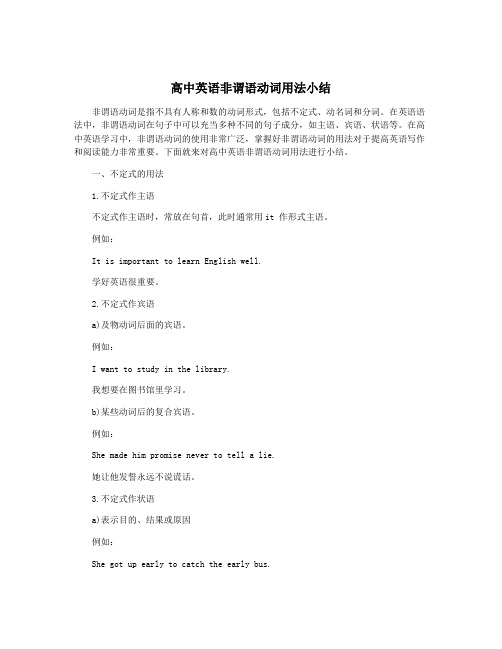
高中英语非谓语动词用法小结非谓语动词是指不具有人称和数的动词形式,包括不定式、动名词和分词。
在英语语法中,非谓语动词在句子中可以充当多种不同的句子成分,如主语、宾语、状语等。
在高中英语学习中,非谓语动词的使用非常广泛,掌握好非谓语动词的用法对于提高英语写作和阅读能力非常重要。
下面就来对高中英语非谓语动词用法进行小结。
一、不定式的用法1.不定式作主语不定式作主语时,常放在句首,此时通常用it 作形式主语。
例如:It is important to learn English well.学好英语很重要。
2.不定式作宾语a)及物动词后面的宾语。
例如:I want to study in the library.我想要在图书馆里学习。
b)某些动词后的复合宾语。
例如:She made him promise never to tell a lie.她让他发誓永远不说谎话。
3.不定式作状语a)表示目的、结果或原因例如:She got up early to catch the early bus.她早早起床是为了赶上早班车。
b)表示方式、条件等例如:People may use calculators to calculate.人们可以使用计算器来计算。
二、动名词的用法动名词可以作主语、宾语、表语或者定语,并且可以放在be 动词、实义动词和介词后面。
动名词也经常与情态动词、不定式和被动语态连用。
1.动名词作主语例如:Swimming is good for health.游泳对健康有益。
2.动名词作宾语动名词可以作及物动词的宾语,也可以作介词后面的宾语。
例如:I enjoy reading books.我喜欢读书。
4.动名词作定语例如:The girl sitting next to me is my best friend.坐在我旁边的那个女孩是我最好的朋友。
三、分词的用法分词包括现在分词和过去分词,它们可以作状语、定语、表语、主语、宾语等。
高中英语非谓语动词用法小结

高中英语非谓语动词用法小结一、不定式1. 不定式的形式:to + 动词原形2. 不定式作目的状语不定式常用于表示目的的短语中,可以置于句首、句中或句末。
例如:- He came to help us.- I work hard to pass the exam.- We need to study hard in order to succeed.7. 不定式的完成形式不定式的完成形式为to have + 过去分词,用来表示动作发生在不定式之前。
例如:- I am glad to have finished my work.8. 动词不定式的主动形式与被动形式动词不定式有主动形式与被动形式。
被动形式是由to be + 过去分词构成的。
主动形式用于表示主动或被动,被动形式用于表示被动。
例如:- I want to finish my homework.(主动)- I want my homework to be finished.(被动)二、动名词1. 动名词的构成动名词的基本形式是动词的-ing形式。
2. 动名词作主语动名词可以作主语。
当动名词作主语时,谓语动词通常用单数形式。
例如:- Smoking is bad for your health.- Swimming is a popular sport.三、现在分词和过去分词1. 现在分词的构成现在分词由动词原形+ing构成。
3. 过去分词的构成过去分词分为规则变化和不规则变化两种。
小结:高中英语非谓语动词主要包括不定式、动名词、现在分词和过去分词。
不定式可以作目的状语、结果状语、定语和后置定语等;动名词可以作主语、宾语、介词宾语和表语等;现在分词可以作定语和表语等;过去分词可以作定语和表语等。
熟练掌握非谓语动词的用法,能够使语言更加准确、丰富,提高表达的灵活性和准确性。
非谓语动词动词不定式的用法
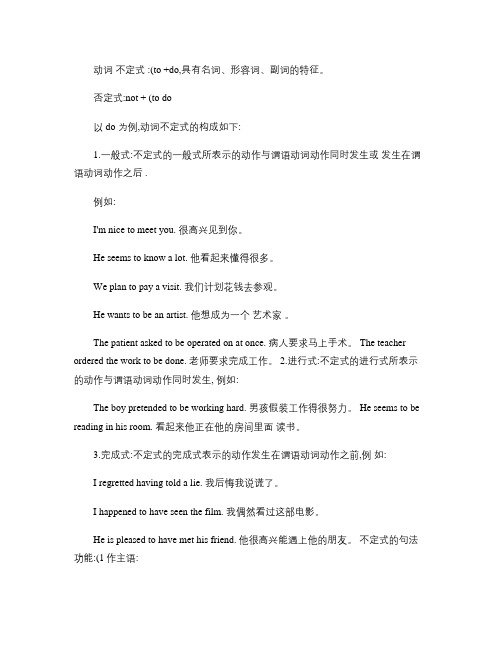
动词不定式 :(to +do,具有名词、形容词、副词的特征。
否定式:not + (to do以 do 为例,动词不定式的构成如下:1.一般式:不定式的一般式所表示的动作与谓语动词动作同时发生或发生在谓语动词动作之后 .例如:I'm nice to meet you. 很高兴见到你。
He seems to know a lot. 他看起来懂得很多。
We plan to pay a visit. 我们计划花钱去参观。
He wants to be an artist. 他想成为一个艺术家。
The patient asked to be operated on at once. 病人要求马上手术。
The teacher ordered the work to be done. 老师要求完成工作。
2.进行式:不定式的进行式所表示的动作与谓语动词动作同时发生, 例如:The boy pretended to be working hard. 男孩假装工作得很努力。
He seems to be reading in his room. 看起来他正在他的房间里面读书。
3.完成式:不定式的完成式表示的动作发生在谓语动词动作之前,例如:I regretted having told a lie. 我后悔我说谎了。
I happened to have seen the film. 我偶然看过这部电影。
He is pleased to have met his friend. 他很高兴能遇上他的朋友。
不定式的句法功能:(1作主语:To finish the work in ten minutes is very hard. 十分钟之内完成这项工作是很难的。
To lose your heart means failure. 灰心意味着失败。
动词不定式短语作主语时,常用 it 作形式主语,真正的主语不定式置于句后,例如上面两句可用如下形式:It is very hard to finish the work in ten minutes. 十分钟之内完成这项工作是很难的。
高中英语知识点归纳非谓语动词的特殊形式和用法

高中英语知识点归纳非谓语动词的特殊形式和用法非谓语动词是英语中的一种特殊用法,不具备人称和数的变化,不可作谓语,常以动词形式出现在句子中。
本文将针对高中英语中非谓语动词的特殊形式和用法进行归纳总结。
一、非谓语动词的特殊形式1. 动词不定式(Infinitive)动词不定式以to+动词原形构成,可以作主语、宾语、表语、定语或状语。
例如:To learn a foreign language is important.(作主语)2. 现在分词(Present Participle)现在分词以-ing结尾,可以作定语、表语或状语。
例如:The girl sitting next to me is my sister.(作定语)3. 过去分词(Past Participle)过去分词可以作定语、表语、状语或动词的宾语补足语。
例如:The broken vase belongs to my grandmother.(作定语)二、非谓语动词的用法1. 不定式作主语示例:To make a decision is not easy.2. 不定式作宾语示例:I want to visit Paris next summer.3. 不定式作表语示例:His dream is to become a doctor.4. 不定式作定语示例:He needs a book to read in his spare time.5. 不定式作状语示例:I went to the library to study.6. 现在分词作定语示例:The students sitting at the back of the classroom are talking.7. 现在分词作表语示例:The book is interesting.8. 现在分词作状语示例:Crying loudly, the baby woke up the whole neighborhood.9. 过去分词作定语示例:The broken glass cut my finger.10. 过去分词作表语示例:I am excited about the news.11. 过去分词作状语示例:Having finished his homework, he went out to play basketball.以上便是高中英语中非谓语动词的特殊形式和用法的归纳总结。
高中英语非谓语动词用法小结

高中英语非谓语动词用法小结非谓语动词指的是动词的非限定形式,不受主语和谓语的人称和数的限制。
在英语中,非谓语动词主要有不定式、动名词和分词三种形式。
非谓语动词的用法较为灵活,包括作主语、作宾语、作状语等多种用法。
本文将对高中英语非谓语动词的用法进行简要总结。
一、不定式的用法:1. 作主语:动词不定式常常作为句子的主语,可以用it作形式主语,把不定式放在句尾,句子采用完全倒装句的形式,例如:It is dangerous to swim in the river.去河里游泳是危险的。
2. 作宾语:动词不定式常常作为及物动词的宾语,例如:I want to go shopping.我想去购物。
3. 作表语:动词不定式作表语,和主语之间用系动词be连系,例如:Her dream is to become a doctor.她的梦想是成为一名医生。
4. 作状语:动词不定式可以作状语表示目的、原因、结果等,例如:He went to the library to borrow some books.他去图书馆借书。
二、动名词的用法:Reading is my favorite hobby.阅读是我最喜欢的爱好。
His job is teaching English.他的工作是教英语。
1. 现在分词作定语:现在分词常常作为名词前的定语,修饰名词,例如:I saw a girl playing the piano in the park.我在公园里看到一个女孩在弹钢琴。
Seeing the accident, he called the police immediately.看到事故,他立刻报警了。
非谓语动词todo的用法小结
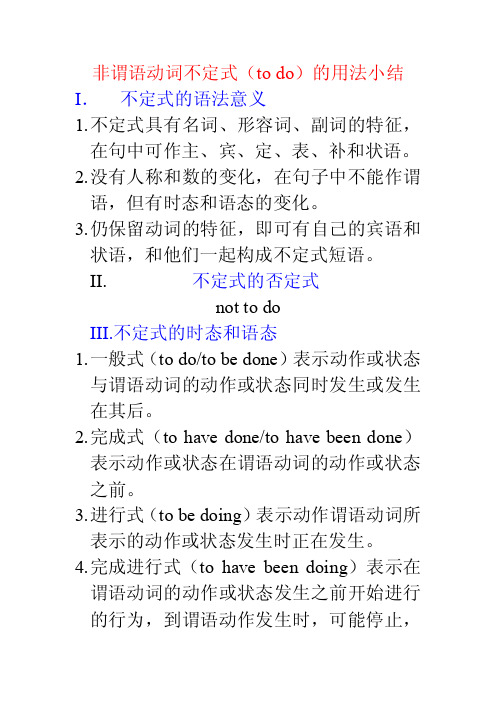
非谓语动词不定式(to do)的用法小结I.不定式的语法意义1.不定式具有名词、形容词、副词的特征,在句中可作主、宾、定、表、补和状语。
2.没有人称和数的变化,在句子中不能作谓语,但有时态和语态的变化。
3.仍保留动词的特征,即可有自己的宾语和状语,和他们一起构成不定式短语。
II. 不定式的否定式not to doIII.不定式的时态和语态1.一般式(to do/to be done)表示动作或状态与谓语动词的动作或状态同时发生或发生在其后。
2.完成式(to have done/to have been done)表示动作或状态在谓语动词的动作或状态之前。
3.进行式(to be doing)表示动作谓语动词所表示的动作或状态发生时正在发生。
4.完成进行式(to have been doing)表示在谓语动词的动作或状态发生之前开始进行的行为,到谓语动作发生时,可能停止,也可能会持续下去。
IV.不定式的功能1.作主语:(1)to do可直接作主语,表示特指一个具体动作。
eg.To swim in that river is very dangerous.To study English well isn’teasy.(2) 用it作为形式主语,而把真正的不定式主语放到句中。
常见的有6种。
It is +adj+ to do sth.eg.It is nice not to be dependent onothers.It is +adj+for sb to do sth.eg.It is not hard for one to do a bit of goodIt is +adj+of sb to do sth.eg. It is silly of you to believe him.= You are silly to believe him.It is +noun+to do sth.eg.It was not his habit to ask people for things.It+动词(+宾语)+ to do sth.eg.It took me a year to finish writing thebook.It is+介词短语+to do sth.eg.It is beyond my power to answer this question.2.作表语:to do作表语很普遍,多数情况下可换作主语eg.Her job is to teach us maths.To teach us maths is her job.3.作宾语:to do作宾语直接跟在vt 动词后面。
高中英语非谓语动词用法小结
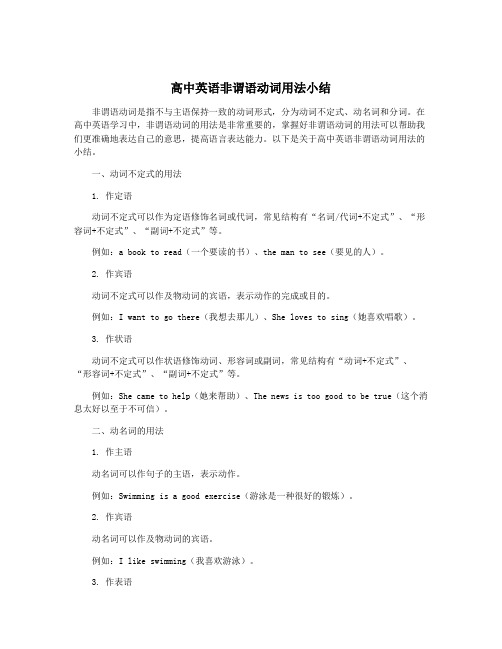
高中英语非谓语动词用法小结非谓语动词是指不与主语保持一致的动词形式,分为动词不定式、动名词和分词。
在高中英语学习中,非谓语动词的用法是非常重要的,掌握好非谓语动词的用法可以帮助我们更准确地表达自己的意思,提高语言表达能力。
以下是关于高中英语非谓语动词用法的小结。
一、动词不定式的用法1. 作定语动词不定式可以作为定语修饰名词或代词,常见结构有“名词/代词+不定式”、“形容词+不定式”、“副词+不定式”等。
例如:a book to read(一个要读的书)、the man to see(要见的人)。
2. 作宾语动词不定式可以作及物动词的宾语,表示动作的完成或目的。
例如:I want to go there(我想去那儿)、She loves to sing(她喜欢唱歌)。
3. 作状语动词不定式可以作状语修饰动词、形容词或副词,常见结构有“动词+不定式”、“形容词+不定式”、“副词+不定式”等。
例如:She came to help(她来帮助)、The news is too good to be true(这个消息太好以至于不可信)。
二、动名词的用法1. 作主语动名词可以作句子的主语,表示动作。
例如:Swimming is a good exercise(游泳是一种很好的锻炼)。
2. 作宾语动名词可以作及物动词的宾语。
例如:I like swimming(我喜欢游泳)。
3. 作表语动名词可以作系动词的表语,表示主语的状态或性质。
例如:His hobby is swimming(他的爱好是游泳)。
4. 作宾语补足语动名词可以作及物动词的宾语补足语,表示动作的结果或目的。
例如:He enjoys reading(他喜欢阅读)。
三、分词的用法1. 现在分词的用法现在分词常常表示伴随、时间、原因等。
例如:Walking along the street, I met an old friend(沿街走着,我碰到了一个老朋友)。
非谓语动词的三种形式及用法总结

非谓语动词的三种形式及用法总结非谓语动词是汉语中非常常用的一种语法成分。
非谓语动词不仅仅是汉语中的一种动词,它也可以用来表达一种动态的概念,也可以作为一种语法结构。
根据不同的用法,可以将非谓语动词分为三种形式:不定式,动名词和分词。
本文将介绍非谓语动词的三种形式,以及它们的用法。
首先,不定式是最常用的非谓语动词形式,它在句子中作为宾语、状语或补语使用,一般以动词原形开头,跟着助动词“to”。
不定式有两种:完成不定式和未完成不定式。
完成不定式表示动作已经完成,未完成不定式表示动作还未发生。
例如:I want to go to the store (我想去商店),I have already gone to the store (我已经去过商店)。
其次,动名词是完成形式的一种,它表示一个动作的进行或完成的状态,一般以动词的原形开头,跟着助动词“to”。
动名词也可以用作宾语、定语、状语或补语等。
例如:I like watching movies (我喜欢看电影),She doesn like going shopping (她不喜欢购物)。
最后,分词是变位语法的一种,它是一种过去分词或现在分词,分词用来修饰句子中的名词或代词。
分词表示一个被动的动作或过去某一时间发生的动作,按照时态可以分为过去分词和现在分词。
例如:I saw him running (我看见他在跑步),He said he was leaving (他说他正要离开)。
总的来说,非谓语动词是汉语中最常用的一种语法成分,它们在句子中可以用作宾语、状语、补语或定语等,它们的作用是使句子的意义更加完整明确,更加准确地表达说话者的意思。
以上就是有关非谓语动词的三种形式及用法总结,希望能够帮助你更好地使用非谓语动词。
非谓语动词todo的用法小结

非谓语动词不定式(to do)的用法小结I.不定式的语法意义1.不定式具有名词、形容词、副词的特征,在句中可作主、宾、定、表、补和状语。
2.没有人称和数的变化,在句子中不能作谓语,但有时态和语态的变化。
3.仍保留动词的特征,即可有自己的宾语和状语,和他们一起构成不定式短语。
II. 不定式的否定式not to doIII.不定式的时态和语态1.一般式(to do/to be done)表示动作或状态与谓语动词的动作或状态同时发生或发生在其后。
2.完成式(to have done/to have been done)表示动作或状态在谓语动词的动作或状态之前。
3.进行式(to be doing)表示动作谓语动词所表示的动作或状态发生时正在发生。
4.完成进行式(to have been doing)表示在谓语动词的动作或状态发生之前开始进行的行为,到谓语动作发生时,可能停止,也可能会持续下去。
IV.不定式的功能1.作主语:(1)to do可直接作主语,表示特指一个具体动作。
eg.To swim in that river is very dangerous.To study English well isn’teasy.(2) 用it作为形式主语,而把真正的不定式主语放到句中。
常见的有6种。
It is +adj+ to do sth.eg.It is nice not to be dependent onothers.It is +adj+for sb to do sth.eg.It is not hard for one to do a bit of goodIt is +adj+of sb to do sth.eg. It is silly of you to believe him.= You are silly to believe him.It is +noun+to do sth.eg.It was not his habit to ask people for things.It+动词(+宾语)+ to do sth.eg.It took me a year to finish writing thebook.It is+介词短语+to do sth.eg.It is beyond my power to answer this question.2.作表语:to do作表语很普遍,多数情况下可换作主语eg.Her job is to teach us maths.To teach us maths is her job.3.作宾语:to do作宾语直接跟在vt 动词后面。
非谓语用法总结-高考完整版
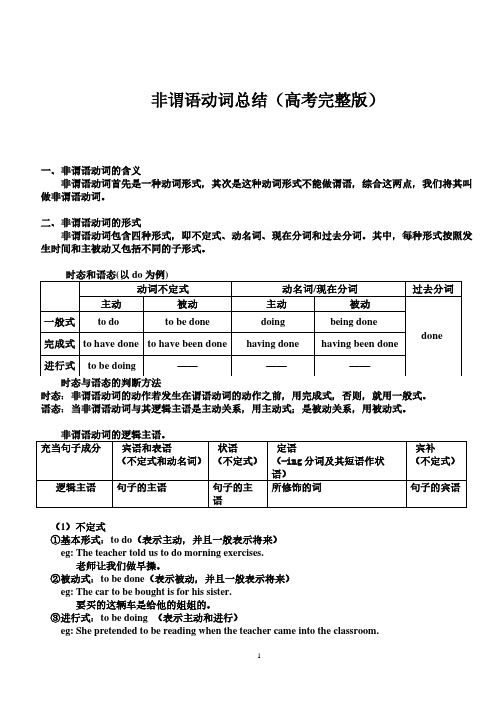
非谓语动词总结(高考完整版)一、非谓语动词的含义非谓语动词首先是一种动词形式,其次是这种动词形式不能做谓语,综合这两点,我们将其叫做非谓语动词。
老师进来时,她假装正在读书。
④完成时:to have done(表示主动和完成)eg: The thief is said to have escaped.据说小偷已经逃跑了。
⑤完成被动式:to have been done(表示被动和完成)eg:The thief is said to have been arrested.据说小偷已经被抓住了。
⑥完成进行式:to have been doing (表示主动和完成进行)eg: She is said to have been working in the factory over the last 20 years.据说在过去的20年里,她一直在这家工厂工作。
(2)动名词①基本形式:doing (表示主动)eg: Travelling in space by ordinary people will be common in the future.在未来,普通人在太空旅行将会是普遍的事情。
②被动式:being done(表示被动)eg: Freddy and his band could go nowhere without being followed by their fans.弗雷迪和他的乐队到哪里都被他们的粉丝跟着。
③完成式:having done(表示主动和完成)eg: I have no idea of his having done such a thing against you.我不知道他做过这样一件违背你的事情。
④完成被动式:having been done(表示被动和完成)eg: Many customers complain of having been given short weight at that shop.很多顾客抱怨在那家商店被缺斤少两过。
非谓语动词 之动词不定式(to do)的用法
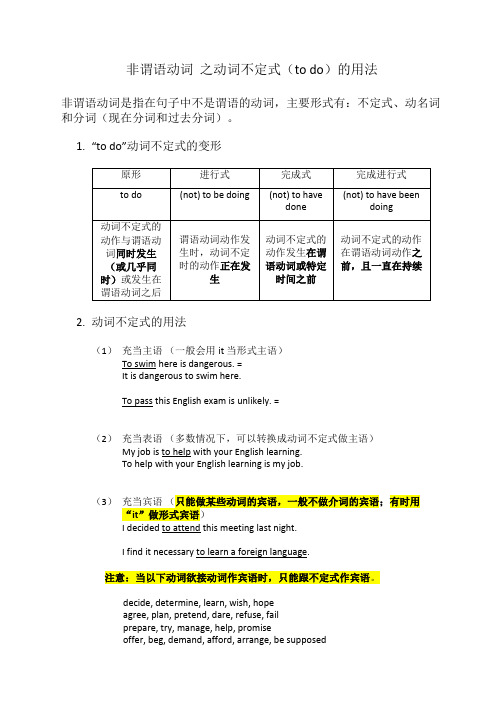
非谓语动词之动词不定式(to do)的用法非谓语动词是指在句子中不是谓语的动词,主要形式有:不定式、动名词和分词(现在分词和过去分词)。
1.“to do”动词不定式的变形2.动词不定式的用法(1)充当主语(一般会用it 当形式主语)To swim here is dangerous. =It is dangerous to swim here.To pass this English exam is unlikely. =(2)充当表语(多数情况下,可以转换成动词不定式做主语)My job is to help with your English learning.To help with your English learning is my job.(3)充当宾语(只能做某些动词的宾语,一般不做介词的宾语;有时用“it”做形式宾语)I decided to attend this meeting last night.I find it necessary to learn a foreign language.注意:当以下动词欲接动词作宾语时,只能跟不定式作宾语。
decide, determine, learn, wish, hopeagree, plan, pretend, dare, refuse, failprepare, try, manage, help, promiseoffer, beg, demand, afford, arrange, be supposed(4)充当宾语补足语I persuaded him to make a speech in public.注意:在感官动词/使役动词/help后(see, hear, watch, notice, make,have, let后不定式做宾补时,可省略“to”)I saw them have a disagreement on who should sweep the floor. (我看到了他们争论的整个过程)但,感官动词后面也可接Ving形式,表示正在进行。
非谓语不定式的用法总结

非谓语不定式的用法总结
1. 嘿呀,非谓语不定式可以用来表示目的呢!就像“我去超市买东西
to get some food”,这里的“to get some food”就是为了说明去超市
的目的呀!
2. 哇塞,它还能用来作后置定语呢!比如“我有很多作业要做 a lot of homework to do”,这“to do”不就很巧妙地修饰了“homework”嘛!
3. 嘿,非谓语不定式有时还能表达结果呢!像“他跑得太快,以至于摔倒了He ran so fast as to fall down”,这结果是不是很直接呀!
4. 哎呀呀,还能表示出乎意料的结果呢!好比“她太粗心了,以至于犯了个大错She was so careless as to make a big mistake”,让人意想不到吧!
5. 嘿,它也能在某些形容词后作状语哦!像“我很高兴能见到你 I'm very glad to see you”,“to see you”不就很好地说明了高兴的原因嘛!
6. 哇哦,非谓语不定式还有一个很棒的用法呢,就是和疑问词连用呀!比如“我不知道该做什么 I don't know wh at to do”,多实用呀!
7. 嗨呀,它在句子中能起到好多作用呢,就如同一个小魔法!大家一定要好好掌握呀!
我的观点结论就是:非谓语不定式的用法真的很多很重要,大家一定要熟练运用呀!。
- 1、下载文档前请自行甄别文档内容的完整性,平台不提供额外的编辑、内容补充、找答案等附加服务。
- 2、"仅部分预览"的文档,不可在线预览部分如存在完整性等问题,可反馈申请退款(可完整预览的文档不适用该条件!)。
- 3、如文档侵犯您的权益,请联系客服反馈,我们会尽快为您处理(人工客服工作时间:9:00-18:30)。
高考非谓语动词不定式用法小结动词不定式用法小结与第一单元重点词汇动词不定式用法小结动词不定式是一种非谓语动词形式,其结构为“to+动词原形”,其中to不是介词,而是动词不定式的符号,称为小品词,动词不定式没有人称和数的变化。
动词不定式和其后面的名词等构成不定式短语,在句子中可以用作主语、表语、宾语、补足语、定语、状语等。
一. 作主语例如:To be a doctor is hard. 做医生很难。
To learn English well is not easy. 学好英语不容易。
动词不定式(短语)作主语时,为了避免句子的头重脚轻,可以用“it”作形式主语,而把真正的主语--动词不定式(短语)放在句子的后部。
例如上面的句子可以表示为:It is hard to be a doctor.It is not easy to learn English well.如果动词不定式的动作是谁做的,可以在动词不定式前面加一个由介词for引导的短语,称为不定式的复合结构。
例:It’s good for us to read English aloud in the morning.对我们来说每天早晨大声读英语是很有益的。
It is important for students to use English every day.对学生来说每天使用英语是很重要的。
二. 作表语:动词不定式(短语)作表语常用于系词be的后面。
例:His work is to drive a car. 他的工作是开车。
My job is to feed animals. 我的工作是饲养动物。
Her ambition is to be a doctor. 她的理想是当医生。
三. 作宾语动词不定式(短语)可以放在一些动词后面用作宾语,能以动词不定式作宾语的动词有:begin,start, want, forget, remember, show,learn, like, hate, love, ask等。
例:They begin to work at eight every morning. 他们每天早晨8点开始工作。
Would you like to go and have a picnic with us tomorrow? 明天和我们一起去野餐好吗?(1)如果and连接两个动词不定式,第二个动词不定式一般省“to”例:He wants to go and have a swim with us. 他想和我们一起去游泳。
(2)若作宾语的动词不定式(短语)很长,可用it作形式宾语。
I find it interesting to learn English with you. 我觉得和你一起学英语很有趣。
He found it hard to catch up with others. 他觉得赶上别人很困难。
四. 作宾语补足语。
The teacher asked us to read English for half an hour in the morning 老师让我们早晨读半小时英语。
The teacher often tells Jim not to spend too much time playing computer games.Please let me help you. 让我来帮助你。
动词不定式作宾语补足语,表示宾语所做的动作,可以用动词不定式作宾语补足语的动词有:tell, ask, want, like, invite, encourage, help等。
但在let, make, see, watch, hear, feel, notice, have等感官听觉动词或使役动词后面作宾语补足语的动词不定式一般要省略动词不定式符号“to”,可以归纳为以下三种句式:1.不可以省to的不定式作宾语补足语:tell /ask / want / would like / wish / like / invite /encourage /teach sb. to do sth.例:I want you to go now. 我想让你现在就走。
Her parents wish her to be a teacher. 她父母亲希望她当老师。
2.省“to”的不定式作宾语补足语:1)Let / make / have sb. do sth.Let the boy go out now. 让那个男孩出去。
The boy made the baby cry. 男孩弄哭了这个小孩。
2)see / watch / hear / notice / feel sb. do sth.I saw the students play basketball on the playground yesterday. 昨天我看见学生们在操场打篮球。
I often hear the girl sing in the next room. 我经常听到女孩在隔壁唱歌。
3)would rather,had better句型后4)Why… / why no t…句型后5)but和except后。
but前是实义动词do时,后面出现的不定式不带to。
比较:He wants to do nothing but go out. 他只想出去玩。
He wants to believe anything but to take the medicine. 除了吃这药,他什么都信。
3.可省可不省的:1)help sb. (to)do sth. I often help my mother (to)do housework. 我经常帮妈妈做家务。
2)由and, or和than连接的两个不定式,第二个to 可以省去:3)通常在discover, imagine, suppose, think等词后作宾补时,可以省去to be。
例如:He is supposed (to be)nice.他应该是个好人。
*动词不定式的否定式是直接在to之前加not. 例:Tell them not to play football in the street. 告诉他们不要在街道上踢足球。
省to的动词不定式的否定式是直接在动词前面加not. 例:Let the boy not go. 让那个男孩别走。
如果将主动语态变为被动语态时,作宾语补足语的动词不定式变为主语补足语,动词不定式则不省“to”,即原来省的再加上,例:The boy made the baby cry.The baby was made to cry by the boy. 那个孩子被男孩弄哭了。
五. 动词不定式作定语动词不定式作定语常用来修饰名词或不定代词,放于所修饰的词后,为后置定语。
例:Who was the first one to arrive? 谁第一个到的?She has no paper to write on? 她没有纸写字?The best way to learn English is to use it. 学英语最好的方法是使用它。
When is the best time to plant vegetables? 什么时候是种植蔬菜的最好时间?Do you have something to drink? 你这有喝的吗?*动词不定式(短语)作定语修饰名词时,与其所修饰的词具有一种动宾关系,如果不定式中的动词为不及物动词时,其后应加上一个含义上所需要的介词。
例:I have no chair to sit on.我没有椅子坐。
He has no house to live in. 他没有房子住。
六. 动词不定式作状语动词不定式作目的状语常用结构为to do , only to do(仅仅为了), in order to do,so as to do,so(such)… as to…(如此…以便…)He went to see his sister yesterday. 他昨天去看妹妹了。
They got up early to catch the early bus. 他们早起去赶早班车。
动词不定式作结果状语,可以表示没有预料到的或事与愿违的结果,不定式要放在句子后面。
I awoke to find my truck gone. 我醒来发现箱子不见了。
He searched the room only to find nothing. 他搜索了房间,没发现什么七. 不定式和疑问词连用,可以作句子的主语、宾语、表语等。
例:The problem is where to get a computer. (表语)No one knows how to do it. 没有人知道如何做这件事。
(宾)I really don’t know which one to choose. (宾)我真的不知道选哪一个。
When and where to have the party is not known. (主语)何时何地举行联欢还不知道。
*不定式和疑问词连用作宾语时有时可以改为宾语从句。
例:I don’t know what to do next.我不知下一步该做什么?I don’t know what I should do next.注意:It's for sb.和It's of sb.这样的句子中,由于表语形容词性质的不同,导致了不定式逻辑主语标志用for或of的区别。
1)for sb. 句型中的形容词一般为表示事物的特征特点,表示客观形式的形容词,如easy, hard, difficult, interesting, impossible等:例如:It's very hard for him to study two languages. 对他来说学两门外语是很难的。
2)of sb句型中的形容词一般为表示性格,品德,心智能力,表示主观感情或态度的形容词,如good, kind, nice, clever, foolish, right。
例如:It's very nice of you to help me. 你来帮助我,你真是太好了。
用for还是用of 的另一种辨别方法:用介词for或of后面的逻辑主语作句子的主语,用介词前边的形容词作表语,造个句子。
如果通顺用of,不通则用for。
例如:You are nice.(通顺,所以应用of)。
He is hard.(非所表达的意思,不通,因此用for。
)用作介词的toto 可以用作介词,也可用作不定式的标示。
